Workplace Discrimination on the Basis of Gender - A Case Study on Marks & Spencer
33 Pages6870 Words43 Views
Added on 2023-02-01
About This Document
This research project explores workplace discrimination on the basis of gender, focusing on a case study of Marks & Spencer. It examines the impact of discrimination on employee turnover and performance, identifies issues arising from gender discrimination, discusses the benefits of implementing laws and policies related to discrimination, and suggests strategies to reduce discrimination in the organization.
Workplace Discrimination on the Basis of Gender - A Case Study on Marks & Spencer
Added on 2023-02-01
ShareRelated Documents
RESEARCH PROJECT

Table of Contents
TITLE: - Workplace discrimination on the basis of gender- A case study on Marks & Spencer.. 1
INTRODUCTION...........................................................................................................................1
Overview of Research............................................................................................................1
Background of Research.........................................................................................................1
Rationale of Research.............................................................................................................1
Research Aim.........................................................................................................................2
Research Objectives...............................................................................................................2
Research Questions................................................................................................................2
LITERATURE REVIEW................................................................................................................3
Workplace discrimination......................................................................................................3
Issues arising from gender discrimination in Marks & Spencer............................................4
Benefits of implementing laws and policies related to discrimination...................................4
Strategies which can reduce the discrimination in the organisation.......................................5
RESEARCH METHODOLOGY.....................................................................................................6
Type of Investigation..............................................................................................................6
Research philosophy...............................................................................................................6
Research Approach.................................................................................................................7
Research Design.....................................................................................................................7
Data collection........................................................................................................................8
Sampling.................................................................................................................................8
Ethical considerations.............................................................................................................9
Timescales..............................................................................................................................9
DATA ANALYSIS AND INTERPRETATIONS.........................................................................11
RESEARCH OUTCOMES............................................................................................................23
Findings to stakeholders.......................................................................................................23
TITLE: - Workplace discrimination on the basis of gender- A case study on Marks & Spencer.. 1
INTRODUCTION...........................................................................................................................1
Overview of Research............................................................................................................1
Background of Research.........................................................................................................1
Rationale of Research.............................................................................................................1
Research Aim.........................................................................................................................2
Research Objectives...............................................................................................................2
Research Questions................................................................................................................2
LITERATURE REVIEW................................................................................................................3
Workplace discrimination......................................................................................................3
Issues arising from gender discrimination in Marks & Spencer............................................4
Benefits of implementing laws and policies related to discrimination...................................4
Strategies which can reduce the discrimination in the organisation.......................................5
RESEARCH METHODOLOGY.....................................................................................................6
Type of Investigation..............................................................................................................6
Research philosophy...............................................................................................................6
Research Approach.................................................................................................................7
Research Design.....................................................................................................................7
Data collection........................................................................................................................8
Sampling.................................................................................................................................8
Ethical considerations.............................................................................................................9
Timescales..............................................................................................................................9
DATA ANALYSIS AND INTERPRETATIONS.........................................................................11
RESEARCH OUTCOMES............................................................................................................23
Findings to stakeholders.......................................................................................................23
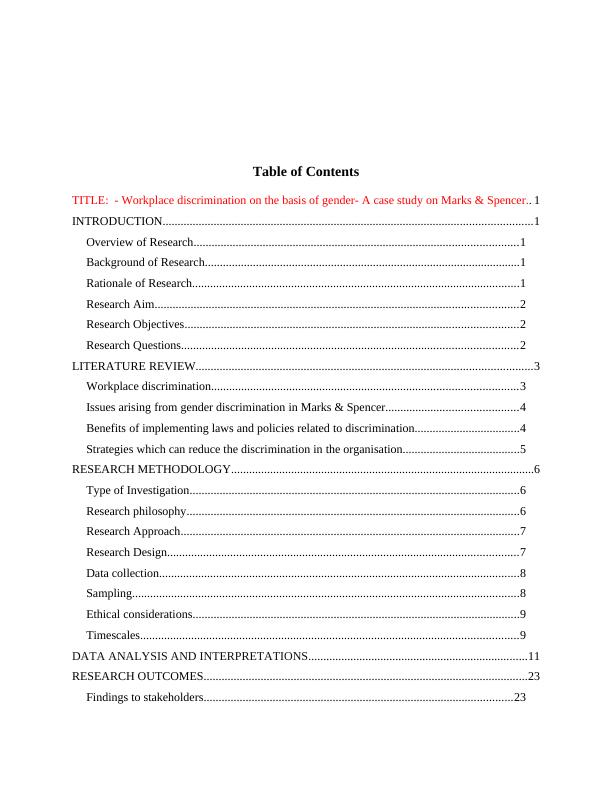
REFLECTION & RECOMMENDATION FOR ALTERNATIVE RESEARCH
METHODOLOGY........................................................................................................................24
Reflection.............................................................................................................................24
Recommendation for alternative research methodology......................................................24
CONCLUSION..............................................................................................................................25
REFERENCES..............................................................................................................................26
METHODOLOGY........................................................................................................................24
Reflection.............................................................................................................................24
Recommendation for alternative research methodology......................................................24
CONCLUSION..............................................................................................................................25
REFERENCES..............................................................................................................................26
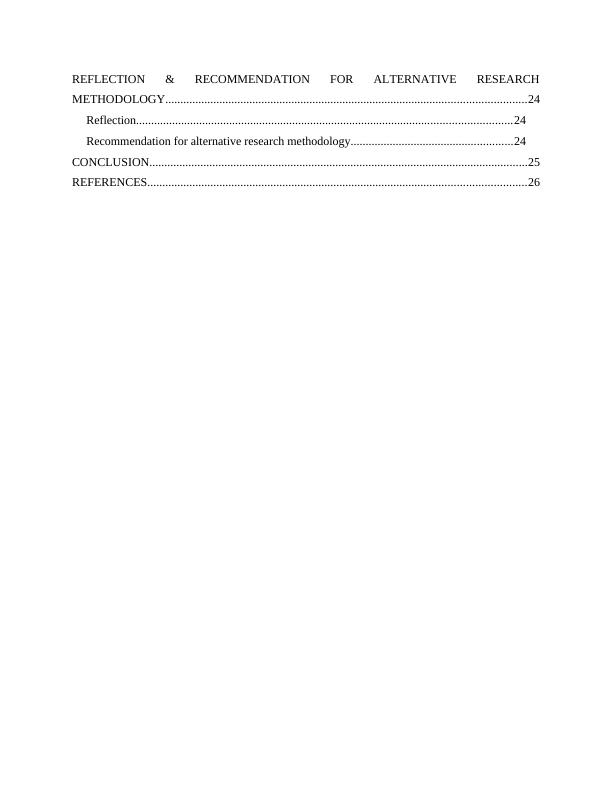
TITLE: - Workplace discrimination on the basis of gender- A case study on
Marks & Spencer.
INTRODUCTION
Overview of Research
The workplace discrimination occurs when a person is discriminated adversely against
because of number of the factors. At workplace, discrimination can be costly and may negatively
impact on reputation of company (Abadeer, 2015). Discrimination is based on the prejudices and
in this employee is treated in unfavourable manner on the basis of race, gender, pregnancy,
disability and others. Present report consists the gender discrimination related issues. Gender
discrimination can take the different forms at workplace and legislation applies to women and
men both. It arises when a company treats employee differently because a person is woman or
man.
Background of Research
Discrimination at workplace result in reinforced the inequalities and reduces morale of
employees. This negatively influence on productivity and profitability of company. Impacts are
not only develops physical impact but also mental can affect on employee performance. The
perceived discrimination has impact on employee as well as working environment. Marks &
Spencer is retail company that mainly provides clothing, home products, grocery items and
others (Antman, 2015). This company has admitted to pay the average female employee around
12.3% less than average male employees which attributing pay gap. This reduced the morale as
well as motivational level of female employees and these impact on organisational productivity.
Other than this, there is a difference in bonus paid to female and male employee was 53.4% with
75% of female staff receiving bonus as comparisons with 66% men.
Rationale of Research
Present research is taken in to consideration on impact of workplace discrimination on
employee turnover and performance. The researcher conducts investigation in personal and
professional context. In context to personal manner, skills and understanding of a learner
enhanced so that any kind of issue will not be arise in conducting an investigation (Baah-
Boateng, 2012). In professional context, researcher can enhance regarding the workplace
Marks & Spencer.
INTRODUCTION
Overview of Research
The workplace discrimination occurs when a person is discriminated adversely against
because of number of the factors. At workplace, discrimination can be costly and may negatively
impact on reputation of company (Abadeer, 2015). Discrimination is based on the prejudices and
in this employee is treated in unfavourable manner on the basis of race, gender, pregnancy,
disability and others. Present report consists the gender discrimination related issues. Gender
discrimination can take the different forms at workplace and legislation applies to women and
men both. It arises when a company treats employee differently because a person is woman or
man.
Background of Research
Discrimination at workplace result in reinforced the inequalities and reduces morale of
employees. This negatively influence on productivity and profitability of company. Impacts are
not only develops physical impact but also mental can affect on employee performance. The
perceived discrimination has impact on employee as well as working environment. Marks &
Spencer is retail company that mainly provides clothing, home products, grocery items and
others (Antman, 2015). This company has admitted to pay the average female employee around
12.3% less than average male employees which attributing pay gap. This reduced the morale as
well as motivational level of female employees and these impact on organisational productivity.
Other than this, there is a difference in bonus paid to female and male employee was 53.4% with
75% of female staff receiving bonus as comparisons with 66% men.
Rationale of Research
Present research is taken in to consideration on impact of workplace discrimination on
employee turnover and performance. The researcher conducts investigation in personal and
professional context. In context to personal manner, skills and understanding of a learner
enhanced so that any kind of issue will not be arise in conducting an investigation (Baah-
Boateng, 2012). In professional context, researcher can enhance regarding the workplace
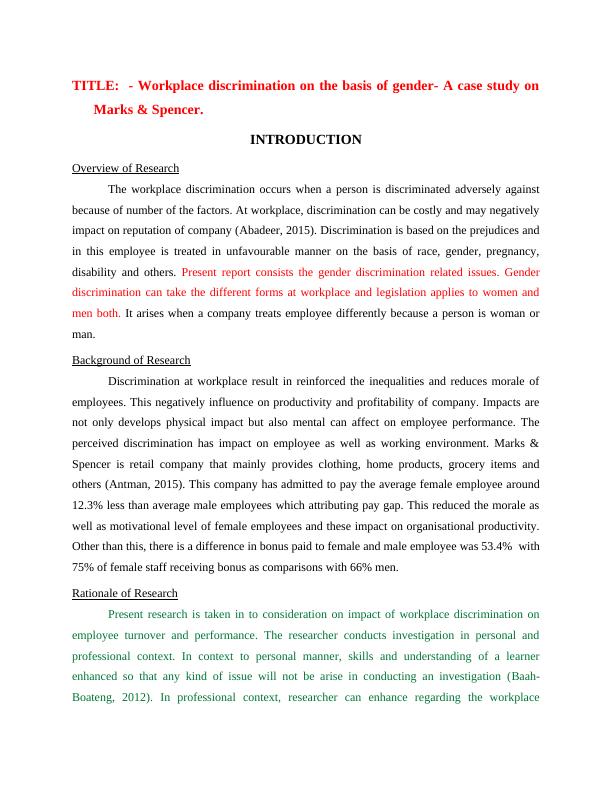
discrimination on the basis of gender at workplace that negative impact on employee
performance as well as turnover. This will helps in give the right direction to researcher to
conduct an investigation in future in systematic manner.
Research Aim
To analyse the impact of workplace discrimination on employee turnover and
performance- A case study on Marks & Spencer.
Research Objectives
To understand the meaning of workplace discrimination.
To identify issues arising from gender discrimination in Marks & Spencer.
To determine the benefits of implementing laws and policies related to discrimination.
To suggest strategies which can redusce the discrimination in the organisation.
Research Questions
What does workplace discrimination mean?
What are the issues arising from gender discrimination in Marks & Spencer?
What are the benefits of implementing laws and policies related to discrimination?
How can discrimination be reduced within the organisation?
performance as well as turnover. This will helps in give the right direction to researcher to
conduct an investigation in future in systematic manner.
Research Aim
To analyse the impact of workplace discrimination on employee turnover and
performance- A case study on Marks & Spencer.
Research Objectives
To understand the meaning of workplace discrimination.
To identify issues arising from gender discrimination in Marks & Spencer.
To determine the benefits of implementing laws and policies related to discrimination.
To suggest strategies which can redusce the discrimination in the organisation.
Research Questions
What does workplace discrimination mean?
What are the issues arising from gender discrimination in Marks & Spencer?
What are the benefits of implementing laws and policies related to discrimination?
How can discrimination be reduced within the organisation?
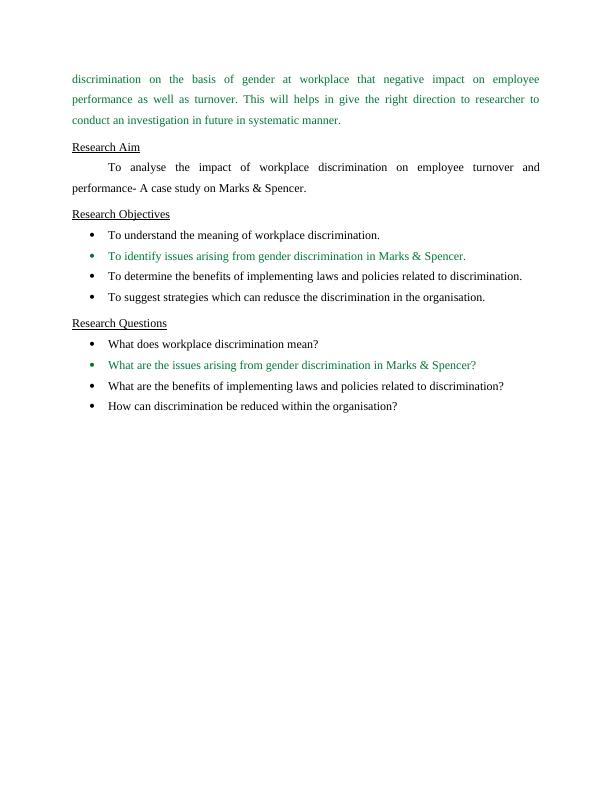
LITERATURE REVIEW
Literature review, also known as narrative review which includes the current
understanding and knowledge of the researcher with respect to the topic. It is pure theoretical
knowledge. Literature review does not include new report or original experiments. It consists of
secondary research, it takes the information from sources which are already available at many
platforms (Barthelemy, McCormick and Henderson, 2016). Such platforms include- author’s
books and journals, articles and so forth. It is a synopsis of your total research study. The
literature presented here are organised in a proper way. It also tells about how your project is
linked with prior researches done before and how it will contribute more in it.
Workplace discrimination
According to opinion of Sarah Benstead (2020) Work discrimination refers to the
inequality done in work place. It is a form of discrimination done with employees based on race,
gender, religion, pay, physical or mental disability, caste, skin colour, national origin or age. The
problem of work discrimination can be found in majority of organisations where one or other
employee does suffer from such discrimination.
Types of work discrimination
Sexual harassment- Sexual harassment is the inappropriate verbal or physical sexual
advancements or request for sexual favours done with employee.
Disability- Discrimination also done with the people who are physically or mentally
challenged. They firstly do not prefer to hire such people or if they hire they don not give much
importance to them which makes them feel inferior. Issues arising from gender discrimination in
Marks & Spencer
Pay scale- In many organisations the pay scale paid to men and women differentiates.
The pay scale paid to men is comparatively high to the pay of women even if both man and
women are on same position and does the same work. Such discrimination decreases the
motivation of woman who is same passionate towards his work as men are (Chen and et. al.,
2013).
Religion & caste- Organisations do performs discrimination towards their employees
with respect of their caste and religion they belong to.
Literature review, also known as narrative review which includes the current
understanding and knowledge of the researcher with respect to the topic. It is pure theoretical
knowledge. Literature review does not include new report or original experiments. It consists of
secondary research, it takes the information from sources which are already available at many
platforms (Barthelemy, McCormick and Henderson, 2016). Such platforms include- author’s
books and journals, articles and so forth. It is a synopsis of your total research study. The
literature presented here are organised in a proper way. It also tells about how your project is
linked with prior researches done before and how it will contribute more in it.
Workplace discrimination
According to opinion of Sarah Benstead (2020) Work discrimination refers to the
inequality done in work place. It is a form of discrimination done with employees based on race,
gender, religion, pay, physical or mental disability, caste, skin colour, national origin or age. The
problem of work discrimination can be found in majority of organisations where one or other
employee does suffer from such discrimination.
Types of work discrimination
Sexual harassment- Sexual harassment is the inappropriate verbal or physical sexual
advancements or request for sexual favours done with employee.
Disability- Discrimination also done with the people who are physically or mentally
challenged. They firstly do not prefer to hire such people or if they hire they don not give much
importance to them which makes them feel inferior. Issues arising from gender discrimination in
Marks & Spencer
Pay scale- In many organisations the pay scale paid to men and women differentiates.
The pay scale paid to men is comparatively high to the pay of women even if both man and
women are on same position and does the same work. Such discrimination decreases the
motivation of woman who is same passionate towards his work as men are (Chen and et. al.,
2013).
Religion & caste- Organisations do performs discrimination towards their employees
with respect of their caste and religion they belong to.
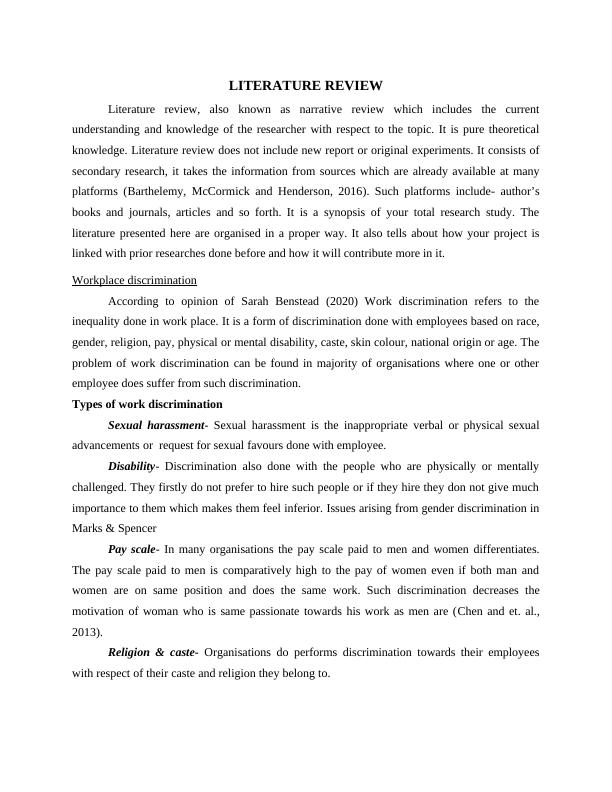
Gender discrimination- Organisations discriminate between man and women. They
prefer to give more opportunities to man as to woman. Opportunities include promotions, high
pay scale, project handling, responsibility given and the like, because they think men can handle
work and pressure more effectively than women.
Skin colour- Preferences given to a particular skin colour is also a point for
discrimination. Any discrimination done with respect of skin colour of an individual is wrong.
Skin discrimination earlier was a major issue in USA as they considered dark skin as the people
meant only for slavery (Cohn, 2019). The white people given good opportunities at work place
over black or dark skin people even though that dark skin had more knowledge or skill for a
particular job.
Equality and diversity policy of Marks & Spencer states that treating everyone on equal
basis regardless of gender, age, colour, disability and some other characteristics. This company
recognise advantages and also diversity values across company. Marks & Spencer is internal
business that committed to creation of inclusive culture where people reflect diverse
communities and gives opportunity of each person.
Issues arising from gender discrimination in Marks & Spencer
According to opinion of Josie Cox (2018) In 2017 report, Marks & Spencer company
identifies a major difference in the ratio between male and female employees. The number of
male working with the organisations were 12.3 percent more to women which comparatively a
little big difference.
Gender discrimination causes the Low productivity among women. The contribution
from females into the organisation will effect as their work were not appreciated by their
employer which results in de-motivation in them regarding work. It also causes high turnover
into an organisation because the women don't feel equal and motivated. It also reflects the
preferences of men over women at the work place. Also it damages the passion into a woman for
live of doing work. They feel neglected in their organisation itself.
To bridge this gender gap the company sign up for '30% club' , a target which promises
of at least 30 percent women on company boards. The company signed up for the above club to
maintain the equal ratios between males and females working for organisation. The company
reached their target by 2012 with 31 percent of women on its board. Also there women account
for 32% of senior management below board level (De Paola and Scoppa, 2015). Not only this,
prefer to give more opportunities to man as to woman. Opportunities include promotions, high
pay scale, project handling, responsibility given and the like, because they think men can handle
work and pressure more effectively than women.
Skin colour- Preferences given to a particular skin colour is also a point for
discrimination. Any discrimination done with respect of skin colour of an individual is wrong.
Skin discrimination earlier was a major issue in USA as they considered dark skin as the people
meant only for slavery (Cohn, 2019). The white people given good opportunities at work place
over black or dark skin people even though that dark skin had more knowledge or skill for a
particular job.
Equality and diversity policy of Marks & Spencer states that treating everyone on equal
basis regardless of gender, age, colour, disability and some other characteristics. This company
recognise advantages and also diversity values across company. Marks & Spencer is internal
business that committed to creation of inclusive culture where people reflect diverse
communities and gives opportunity of each person.
Issues arising from gender discrimination in Marks & Spencer
According to opinion of Josie Cox (2018) In 2017 report, Marks & Spencer company
identifies a major difference in the ratio between male and female employees. The number of
male working with the organisations were 12.3 percent more to women which comparatively a
little big difference.
Gender discrimination causes the Low productivity among women. The contribution
from females into the organisation will effect as their work were not appreciated by their
employer which results in de-motivation in them regarding work. It also causes high turnover
into an organisation because the women don't feel equal and motivated. It also reflects the
preferences of men over women at the work place. Also it damages the passion into a woman for
live of doing work. They feel neglected in their organisation itself.
To bridge this gender gap the company sign up for '30% club' , a target which promises
of at least 30 percent women on company boards. The company signed up for the above club to
maintain the equal ratios between males and females working for organisation. The company
reached their target by 2012 with 31 percent of women on its board. Also there women account
for 32% of senior management below board level (De Paola and Scoppa, 2015). Not only this,
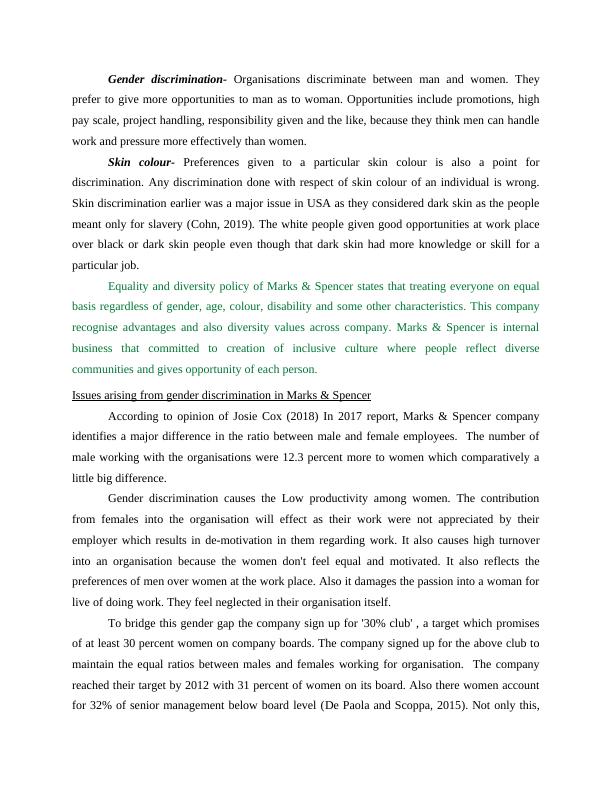
the company encourages women for promotions and also consider them suitable for senior
positions.
Benefits of implementing laws and policies related to discrimination
As per opinion of Marie-Anne Valfort (2020) Combating the discrimination needs
combining strengths of anti- discrimination related policies to addressing weaknesses. Anti
discrimination laws are mainly designed to prevent the discrimination against specific groups of
the people. These are rooted in the equality principles and should not treated because of
characteristic. Through implementing the discrimination legislation at workplace, discrimination
will be reduced and everyone in company can able to perform in a better manner. On the other
hand, equal pay act needs the managers to provide women and men equal pay for the equal work.
The staff members so the equal work when they are able to perform in better manner in same
working situations, responsibilities and efforts. With the help of implementing this act, male and
female employees can work well and they will focus on attaining the specific objectives within
given time period (De Marco, 2012).
Strategies which can reduce the discrimination in the organisation
According to Tony Jeanetta (2019), Managers should provide the equal opportunities to
employees so that they can work effectively and focus on attaining the specific activities. To
reduction in discrimination at workplace helps in reduce confusion and uncertainty between
managers and employees by providing them safe working environment. There is different ways
Marks & Spencer company use to reduce the discrimination from workplace:
Educate- Under this, there is a need to Marks & Spencer to give the inclusion and
diversity related training for staff members. This is necessary that all staff members should know
what arise gender discrimination. It can be on the basis of job responsibilities, promotions etc.
This is essential for company to prevent the racism through cultivating the respect as the
organisational values.
Communicate- It is required for company to encourage the open communication to make
the employees comfortable and discuss the concerned with HR, supervisors at workplace.
Through this, employee will feel better and able to interact with each other (Delavande and
Zafar, 2013).
Build Diversity from the Inside Out- Marks & Spencer company eliminated the
experience needed from job postings. This kind of process is helpful in motivate the qualified
positions.
Benefits of implementing laws and policies related to discrimination
As per opinion of Marie-Anne Valfort (2020) Combating the discrimination needs
combining strengths of anti- discrimination related policies to addressing weaknesses. Anti
discrimination laws are mainly designed to prevent the discrimination against specific groups of
the people. These are rooted in the equality principles and should not treated because of
characteristic. Through implementing the discrimination legislation at workplace, discrimination
will be reduced and everyone in company can able to perform in a better manner. On the other
hand, equal pay act needs the managers to provide women and men equal pay for the equal work.
The staff members so the equal work when they are able to perform in better manner in same
working situations, responsibilities and efforts. With the help of implementing this act, male and
female employees can work well and they will focus on attaining the specific objectives within
given time period (De Marco, 2012).
Strategies which can reduce the discrimination in the organisation
According to Tony Jeanetta (2019), Managers should provide the equal opportunities to
employees so that they can work effectively and focus on attaining the specific activities. To
reduction in discrimination at workplace helps in reduce confusion and uncertainty between
managers and employees by providing them safe working environment. There is different ways
Marks & Spencer company use to reduce the discrimination from workplace:
Educate- Under this, there is a need to Marks & Spencer to give the inclusion and
diversity related training for staff members. This is necessary that all staff members should know
what arise gender discrimination. It can be on the basis of job responsibilities, promotions etc.
This is essential for company to prevent the racism through cultivating the respect as the
organisational values.
Communicate- It is required for company to encourage the open communication to make
the employees comfortable and discuss the concerned with HR, supervisors at workplace.
Through this, employee will feel better and able to interact with each other (Delavande and
Zafar, 2013).
Build Diversity from the Inside Out- Marks & Spencer company eliminated the
experience needed from job postings. This kind of process is helpful in motivate the qualified
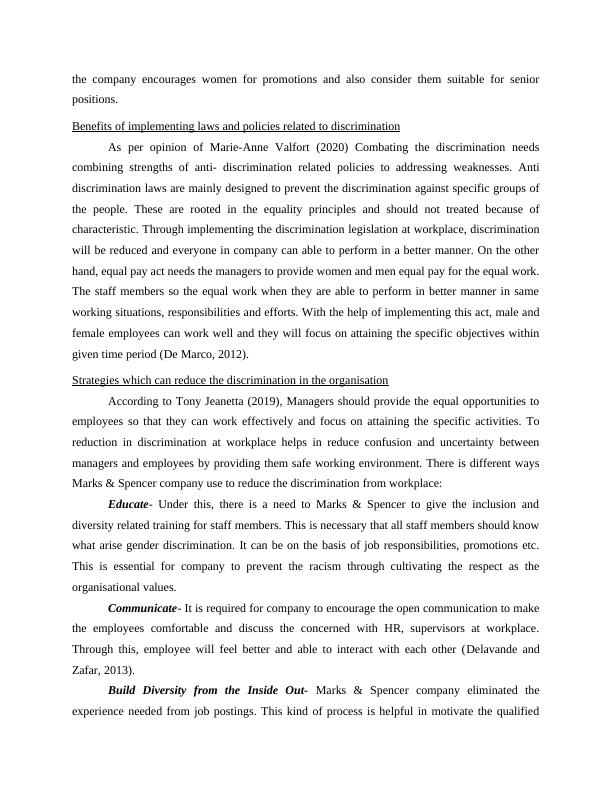
End of preview
Want to access all the pages? Upload your documents or become a member.
Related Documents
Importance of Gender Equality Strategies in Reducing Employee Turnoverlg...
|24
|6461
|1
Impact of gender discrimination on employee performancelg...
|25
|5162
|85
Research project.lg...
|10
|384
|71
Research Projectlg...
|30
|7979
|20
Gender Discrimination and its Impact on Employee Pay: A Case Study on Tescolg...
|9
|1923
|23
Workplace Discrimination: Impact and Preventionlg...
|25
|5646
|87
